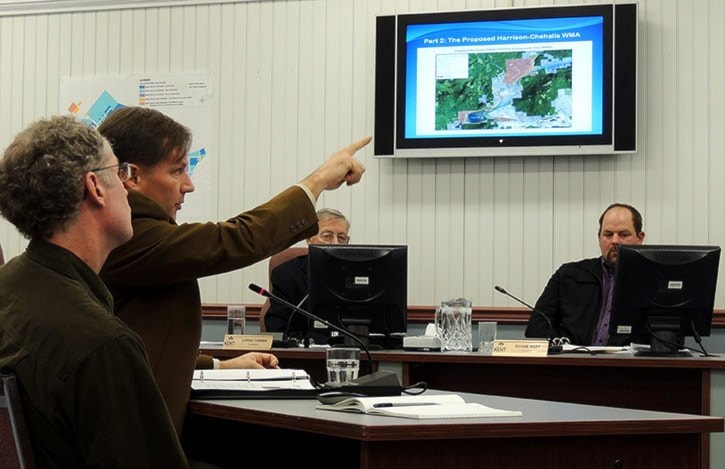A presentation from two representatives from the Ministry of Forests, Lands and Natural Resource Operations didn’t receive a very warm reception in council Monday night.
Jeff Juthans, a land and resource specialist and Brent Gurd, a wildlife biologist, spoke to council about an initiative to designate the Harrison Chehalis area into a wildlife mManagement area.
“Harrison Chehalis area is an ecological hotspot with internationally recognized fish and wildlife conservation values,” Juthans noted. A current plan is in place, and has been since the late 1990s, he said. But in 1997, a designation and draft management plan was started, and that led to further consultation with key proponents — such as the District of Kent and local First Nation bands.
The whole plan was postponed in 2008, to allow for continued consultation, but now the ministry in charge is hoping to start a 45-day consultation process that would begin in mid-2013. While the presentation stated that current uses wouldn’t be affected by the implementation of a wildlife management area, during a question and answer period, Juthans said that activities that contravened the WMA wouldn’t necessarily be tolerated. The purpose of WMA is to provide a special level of management to conserve important fish and wildlife habitats in the context of other important land uses, he said. It also gives the ministry responsible the administrative authority to manage the area and allows for some regulatory tools under the Wildlife Act to be considered in the management of that area. They did say that a WMA designation does not affect First Nation traditional use or cultural use, private property rights or adjacent land use.
Council was quick to point out that the area is doing very well as it is, and that they feared further designations by yet another arm of the government would cause more red tape for property owners, notably farmers.
“Am I picking up that there are environmental regulation concerns?” Juthans asked Mayor John Van Laerhoven.
“Yes,” the mayor responded. “There is definitely a level of concern here. I heard you say the WMA would have no impact on activities that are currently in place?”
“Yes,” Juthans replied. “But I also said if it was in contradiction to the WMA (then there could be an impact).”
“That kind of thing makes farmers and residents very nervous,” the mayor responded.
Many farmers already feel maligned by the amount of government approval needed for maintaining waterways in the District of Kent. Many of the regulations that exist are meant to protect endangered wildlife habitat.
Councillor Lorne Fisher explained the difficulties also relate to the government’s management of the river, and how the lack of gravel removal in recent years is contributing to farming and environmental issues.
“Sooner or later it’s going to have to get dredged or else it’s not going to be a river,” he said. And the Fraser and Harrison Rivers run right through the proposed WMA.
“It is a complicated system that you are looking at in terms of managing to keep people happy, not only people but other species, too,” he said.
The area is a habitat for the white sturgeon, a red listed species, and is known internationally for its significant numbers of bald eagles. Activities that would disrupt nature, such as chasing wildlife or ATV use, would not tolerated in a WMA. Some amenities and facilities could be built in the area, such as information boards, Juthans said.
While Juthans and Gurd work with the ministry of forests, lands and natural resources, the mayor expressed his frustration in dealing with other environmentally-focused ministries.
“A lot of money gets spent trying to work on these regulations than actually gets spent on the maintenance of working on these ditches,” he said. But he did offer an olive branch.
“Maybe if we can help you in one area, you can help us in another,” he said to the delegation. “Because farming is also an endangered species…Are you getting a bit of the flavour of why we’re nervous?”
Juthans wrote down many of the comments during the conversation, and said he would take them back for consideration, and council made a motion to accept the report as information.
